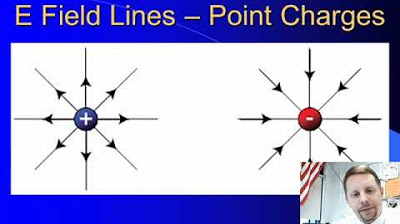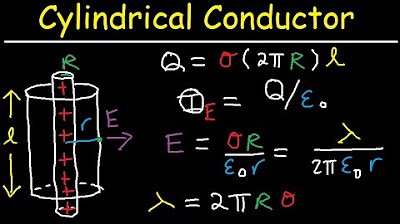Electric Field (1 of 3) An Explanation
TLDRThis video introduces the concept of the electric field, emphasizing its definition as the force per unit charge. It explains the direction of the electric field around a charge, using a test charge to demonstrate that the field points away from positive charges and towards negative ones. The video also touches on the magnitude of the electric field, illustrating it with the density of electric field lines. The formula for calculating the electric field is introduced, highlighting its dependence on the charge and the distance from the charge. The distinction between electric field and electric force is clarified, and the video encourages watching the next installment for practical calculations.
Takeaways
- 📚 The electric field is defined as the force per unit of charge, and it has both magnitude and direction.
- 🧭 To determine the direction of the electric field, use a test charge (a small positive charge) and observe the direction of the force it would experience in the presence of the main charge.
- 🔋 The direction of the electric field around a positive charge is away from it, while around a negative charge, it points towards the charge.
- 🌐 The magnitude of the electric field can be visually represented by the density of electric field lines; closer to the charge, the lines are denser, indicating a stronger field.
- 🔢 The equation for the electric field is E = kQ/d^2, where E is the electric field, k is Coulomb's constant, Q is the charge of the main charge, and d is the distance from the charge.
- 🔄 The electric field is a vector quantity, meaning it has both magnitude and direction, and is distinct from the electric force described by Coulomb's law.
- 🔧 The electric field only requires one charge to exist, whereas the electric force between two charges is governed by Coulomb's law with the formula F = k(q1 * q2)/d^2.
- 📈 The strength of the electric field is inversely proportional to the square of the distance from the charge, meaning it weakens as you move away from the charge.
- 🔍 The electric field can be calculated at any point by using the charge present at that point and the distance from the main charge.
- 🤝 The relationship between the electric field and the force on a charge is given by F = qE, where F is the force, q is the charge, and E is the electric field.
- 🎓 Understanding the concepts of electric field and electric force, as well as their differences and relationships, is crucial for comprehending electromagnetic interactions.
Q & A
What is the primary focus of the video?
-The primary focus of the video is to introduce the concept of the electric field, specifically discussing how to determine its direction and magnitude without performing any calculations.
What is the definition of an electric field?
-The electric field is defined as the force per unit of charge. It is a vector quantity, meaning it has both magnitude and direction.
How is the direction of an electric field determined around a charge?
-The direction of the electric field around a charge is determined by using a test charge, which is a small positive charge. The direction of the force on the test charge indicates the direction of the electric field. For a positive main charge, the electric field points away from the charge, and for a negative main charge, it points towards the charge.
What is a test charge used for?
-A test charge is used to determine the direction of the electric field at a particular point in space. It is a hypothetical, very small positive charge that, when placed in an electric field, experiences a force whose direction indicates the electric field's direction.
How can the magnitude of the electric field be qualitatively represented?
-The magnitude of the electric field can be qualitatively represented by the density of electric field lines. The closer the lines are to each other, the stronger the electric field; conversely, the farther apart they are, the weaker the electric field.
What is the difference between the electric force and the electric field?
-The electric force refers to the force experienced by a charged particle due to the presence of other charges, as described by Coulomb's Law. The electric field, on the other hand, is a field that exists around a charge and describes the force per unit charge that would be experienced by a small test charge placed in that field.
What is the equation for the electric field?
-The equation for the electric field E is given by E = k * Q / d^2, where k is Coulomb's constant, Q is the charge creating the electric field, and d is the distance from the charge.
How does the electric field strength change with distance from the charge?
-The electric field strength is inversely proportional to the square of the distance from the charge. As you move farther away from the charge, the electric field becomes weaker, and as you get closer, it becomes stronger.
What is the relationship between the electric field and the force experienced by a charge?
-The force experienced by a charge in an electric field is given by F = E * q, where F is the force, E is the electric field strength, and q is the charge experiencing the force. This relationship shows that the force is directly proportional to the electric field strength and the amount of charge.
Why is it important to understand the difference between electric force and electric field?
-Understanding the difference between electric force and electric field is important because it allows us to correctly analyze and calculate the interactions between charges. The electric field describes the potential influence on a charge, while the electric force is the actual interaction experienced by the charge. This distinction is crucial for accurately modeling and predicting electrical behavior in various scenarios.
What is suggested for viewers to better understand electric fields?
-The video suggests that viewers should watch both the introduction video and the next video, where simple electric field calculations will be performed. This will provide a comprehensive understanding of how electric fields work.
Outlines
🌟 Introduction to Electric Fields
This paragraph introduces the concept of electric fields, emphasizing the importance of understanding both direction and magnitude. It clarifies that electric fields are vector quantities with both magnitude and direction. The video aims to explain how to determine the direction of the electric field around a charge, using the concept of a test charge, which is a small positive charge used to probe the field without disrupting it. The direction of the electric field is established as being away from positive charges and towards negative charges. The magnitude of the electric field is qualitatively described by the density of electric field lines, with stronger fields indicated by closer lines and weaker fields by lines that are further apart.
📝 Equations and Calculation of Electric Fields
This paragraph delves into the mathematical representation of electric fields, starting with the fundamental equation for electric field strength, which involves Coulomb's constant (K), the charge (Q), and the distance from the charge. It distinguishes between the electric field and the electric force, highlighting that an electric field can exist with just one charge, whereas a force requires two. The explanation continues with how to derive the electric field equation and how it relates to the force experienced by a test charge placed in the field. Additionally, the paragraph introduces another form of the electric field equation that allows for calculating the force on a charge based on the electric field strength and the charge's quantity. The summary encourages watching the next video for further calculations and reiterates the importance of understanding the difference between electric force and electric fields.
Mindmap
Keywords
💡Electric Field
💡Magnitude
💡Direction
💡Test Charge
💡Coulomb's Law
💡Vector
💡Charge
💡Force
💡Density of Electric Field Lines
💡Calculations
💡Introduction
Highlights
Introduction to the concept of the electric field
Explaining the direction and magnitude of the electric field without calculating magnitudes
Emphasizing the importance of understanding electric fields and forces
Clarification that electric field is the force per unit charge and is a vector quantity
Definition of electric field in relation to a single charge
Difference between electric force and electric field
Use of a test charge to determine the direction of the electric field
Direction of the electric field around a positive charge
Direction of the electric field around a negative charge
Representation of the electric field's magnitude with field lines
Equation for the electric field and its components
Explanation of how to derive the electric field equation
Relation between the electric field and the force on a charge
Application of the electric field equation to calculate force on a charge
Advice to watch the next video for electric field calculations
Summary of the differences between electric force and electric field
Encouragement for viewers to engage and interact through likes and comments
Transcripts
Browse More Related Video

Electric Force

How To Draw Electric Field Lines of Point Charges - College Physics

Gauss Law Problems - Infinite Sheet of Charge and Parallel Plate Capacitor - Physics

High School Physics - Electric Fields

Electric Fields: Crash Course Physics #26

Gauss Law Problems, Cylindrical Conductor, Linear & Surface Charge Denisty, Electric Field & Flux,
5.0 / 5 (0 votes)
Thanks for rating: